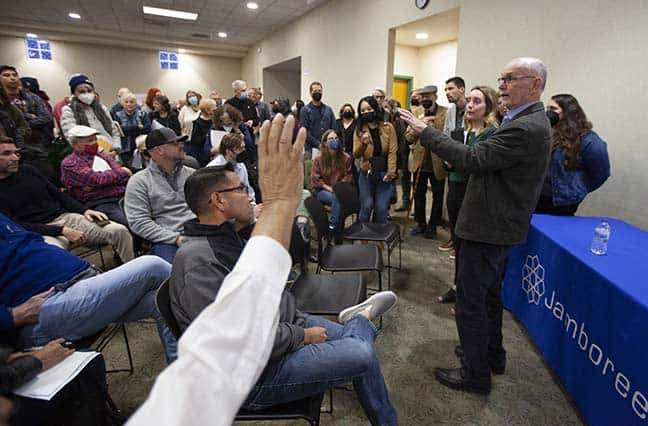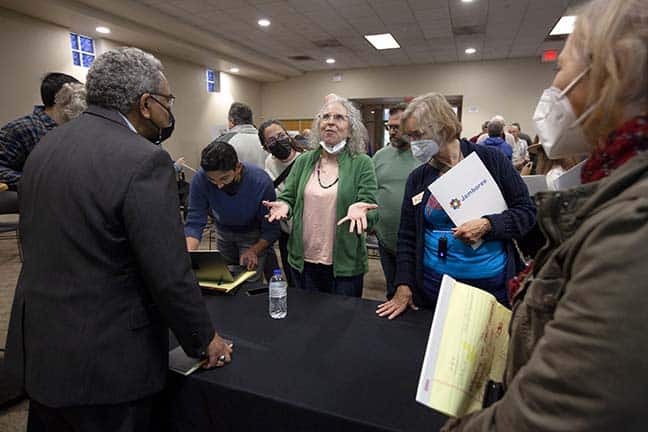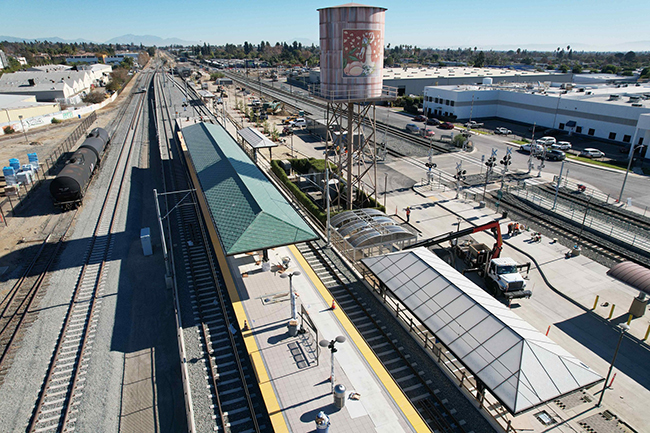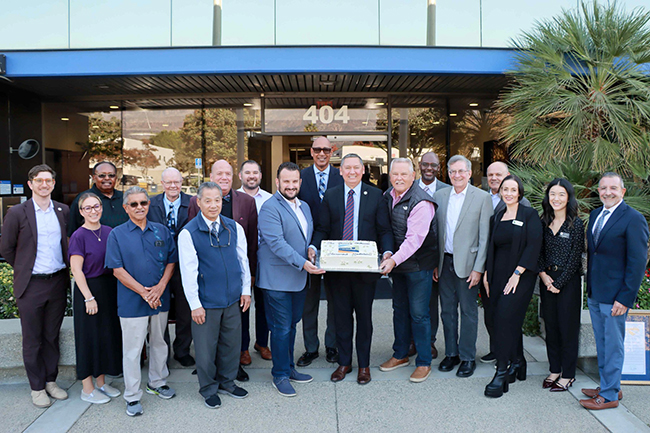Residents hear from developer during Larkin Place meeting

George Searcy, chief impact officer for Jamboree Housing answers a resident’s question last Thursday, during an informational meeting about the proposed permanent supportive housing project Larkin Place. Jamboree wants to build the affordable housing project on a tract of land owned by Pilgrim Place, which is next to Larkin Park on Harrison Avenue. Opponents of the project worry about safety and say it is too close to the park and El Roble Intermediate School. COURIER photo/Steven Felschundneff
by Steven Felschundneff | steven@claremont-courier.com
During a nearly three-hour, sometimes raucous, meeting last Thursday, local residents got their first chance to hear directly from the developer who wants to build affordable housing for formerly homeless people in the City of Claremont.
Jamboree Housing Corporation has proposed constructing a four-story, 33-unit permanent supportive housing development on a vacant, roughly half-acre lot at 731 Harrison Avenue. The project, called Larkin Place, would be limited to extremely low-income people, those who earn at or below 30% of the area median income. It will offer housing, as well as onsite resident services such as counseling, health resources, and adult enrichment and education classes.
The building includes nine studios, 23 one-bedroom units and a two-bedroom manager’s unit. Additional facilities include a community room with kitchen, a leasing space, laundry room, dog run, outdoor barbeque and 18 parking spaces.
Jamboree’s resident services division, Housing with Heart, will most likely provide the onsite management which, “Delivers high quality supportive services necessary to help residents succeed in staying stably housed, as well as oversees the multiple agencies, partners, and volunteers who will also be engaged with the residents,” according to a city report.
In January, the Claremont City Council authorized a $1.5 million loan to Jamboree through its Successor Housing Fund to partially pay for the project. That money comes with a 55-year term, and is contingent on Jamboree completing the project and maintaining it as extremely low-income housing for the entirety of the term. The Claremont Architectural Commission also signed off on the initial design proposal.
“Affordable housing is a high priority of both the city council and the state of California. Providing affordable housing for low-income households is a particularly urgent need throughout the region and this project represents an effort by the city to meet its fair share of this type of housing which is identified by the Regional Housing Needs Assessment and mandated by state housing law,” Community Development Director Brad Johnson said in his staff report to the architectural commission.
The tract is currently owned by Pilgrim Place, which is selling the property specifically for use as extremely low-income development.
Needless to say, Larkin Place has faced considerable resistance, particularly from people who live near the site, which is sandwiched between Larkin Park and the Quaker’s Claremont Friends Meeting location, about a half block from the corner of Mountain and Harrison avenues.
Those who oppose the project have consistently praised the city’s effort to build affordable housing, but say they believe Larkin Place’s location is profoundly flawed due to its proximity to the park, El Roble Intermediate School and a daycare at the First Baptist Church of Claremont. They expressed concerns about the high rate of mental illness and drug addiction among the population from which the new residents would be selected. They say they also worry the development will attract more homeless people, and perhaps drug dealers, to the area which already has a fair amount of unhoused people staying in the park.
“We support permanent supportive housing in an area that is not so close to schools and seniors, where people are vulnerable,” said Linda Mawby, a close neighbor of the property, who also is an urban planner and has worked in affordable housing.
Mawby said her community felt blindsided by the development because so many of her neighbors learned of the plan after the city council had already committed to provide Jamboree with funding.
“That has been our primary purpose all along, to find out what is happening and make that known because we did not know about it. None of the community knew about it. And we thought it was important that the community did know, because it affects every community member in the city,” Mawby said.
Last Thursday, following a brief introduction, representatives from Jamboree proposed breaking the meeting of about 200 people into smaller groups to discuss specifics of the plan. This resulted in loud protests from the crowd, who accused the developer of trying to divide them to blunt their criticism. One woman attempted to commandeer the meeting, taking over the microphone while demanding that they remain together. After attempting for a short time to adhere to the small group model, the attendees got their wish, and the rest of the meeting was conducted with all of the attendees in one place.
The crowd was not a monolith of opposition — Larkin Place had several advocates, including those who support more affordable housing in Claremont. Anna Jacobsen said she attended the meeting to be a positive voice because few cities have taken on projects like this. She said Claremont has an opportunity to be a real leader in providing permanent supportive housing, which has proven to be the most effective way to get people off the street for good.
Angelique Russell agreed, saying homelessness is a regional issue and, “It would be great if more cities embraced this model.”
The majority of the meeting was conducted by George Searcy, chief impact officer for Jamboree. He emphasized the company’s long track record of successfully implementing similar projects that complemented and enhanced the communities where they were built. One example is Courier Place, an affordable apartment complex on College Avenue, developed by Jamboree and completed in 2011.
Questions from the audience focused on how future tenants would be screened, the training and qualifications of the onsite manager, how many people would eventually live in the building, the visitor policy, how security would be addressed and whether the residents would be required to remain sober. Audience members also asked about the building itself, specifically its size, and the plan to have an easement over the parking lot at Larkin Park to access the parking area at Larkin Place.
Permanent supportive housing is not the same as homeless shelters — Larkin Place residents will sign a lease, pay rent and follow rules associated with living in an apartment. As such, they would also have a certain amount of autonomy, which means they will not be drug tested and can have overnight visitors up to 14 days per month.
Tenants would be identified through a countywide referral system administered by the Los Angeles Homeless Services Authority.
The Department of Housing and Urban Development allows two people per studio and three for a one-bedroom unit, meaning the maximum occupancy allowed would be 87. However, the vast majority of residents in this type of housing are singles and couples, so the actual number of tenants would likely be far less and could be as few as 32. The average stay in supportive housing is two years.
“Applicants will not only undergo an extensive vetting process from the county, but will also need to go through a secondary vetting process by the property management team. Management will request that local law enforcement agencies perform a criminal background check for all adult members (age 18 years or older) of the applicant’s household. Applicants who have been convicted of a violent or drug-related crime or are registered sex offenders will not be approved for residency,” according to a special web page set up by the city.
While there are no guarantees that problems will not arise on the part of the formerly homeless people who will eventually live at Larkin Place, Searcy says that has not been the case at other permanent supportive housing projects run by the company. He also listed the onsite manager, security cameras and lighting as measures to maintain safety.
“For people that are in severe crisis that cannot function independently and can’t live successfully in a community, they are not eligible to live here,” Searcy said.
Searcy repeatedly offered that any resident with concerns about the project could tour existing permanent supportive housing built by Jamboree to see how Larkin Place might look and function.
Pilgrim Place CEO Ron Bolding said he understood the residents’ concerns, and that they represent the same issues his organization raised from the beginning when discussions began about how the tract of land might be best utilized.
“Pilgrim Place wanted to do something to contribute to the solution. Clearly, I have not heard much opposition, [the homeless] need to be housed. Where and how? There may be a variety of opinions,” Bolding said. “So our thought was when we were reached out to by Jamboree, as well as the city, that we could make a difference in the homeless population in our city, in particular those you see at in Larkin Park.”
He said the proposed project represented the best way to accommodate a reduction in, but not an elimination of homelessness in Claremont. However, he regrets that Pilgrim Place did not do a better job regarding outreach, which has left so many with unanswered questions.
New state laws mean approval is ‘by right’
California code identifies housing as a critical issue for the state, and requires that “a local government not reject or make infeasible housing development projects, including emergency shelters, that contribute to meeting the need.”
The law also states that affordable housing projects shall not be disapproved by a local agency unless there is a preponderance of evidence that one of five critical conditions apply: the city has met or exceeded its Regional Housing Needs Assessment requirement; the project would have a specific, adverse impact on the public health or safety, and there is no feasible method to mitigate or avoid this impact; the denial of the housing development is required to comply with specific state or federal laws; the proposed project is on land zoned for agriculture or resource preservation; the housing development is inconsistent with both the jurisdiction’s zoning ordinance and general plan land use designation as specified in any element of the general plan.
City planning staff has determined that none of these conditions apply to Larkin Place, and that it is therefore considered a “by right” development, meaning local officials have almost no say in whether or not it gets built.
Since the tract is zoned institutional residential, and has been identified by the city in its housing element for a number of years as an ideal location for affordable housing, this further solidifies it as a location where the state code prevails.
It’s also extremely likely that the building will be four stories despite resident resistance. Because Larkin Place includes 100% low-income housing, the project qualifies for an automatic density bonus of 80%, which boosts the unit count from 17 to 31. The developer has requested two additional units, including one for onsite manager and services. The development also qualifies under state law for a reduction in the number of required parking spaces.
Local residents say the city does still have some leverage, including approving the easement at Larkin Park and the language in the regulatory agreement.
“So, there are some levers here. Granted, there are not a lot of options considering the zoning of the project, but we just want to make sure there is open dialog with the city concerning citizen safety,” said Judy David, who is working as a consultant for the nearby residents.
“We have heard this talking point that the city only has so much control, and we understand that, but that does not mean they can’t be advocates for us,” 10-year resident Jorge Barraza said. “In their January 25 council meeting, many of the council members and many of the city planners were very positive about the relationship between Jamboree, the developer, and the city. There was a lot of trust in that relationship, so saying we can’t do anything about this because legally they [Jamboree] can do whatever they want, but at the same time being willing to support them in multiple ways is mixed messages to our community.”
1 Comment
Submit a Comment
You must be logged in to post a comment.













18 parking spots for that many units??? – that is going to be an issue